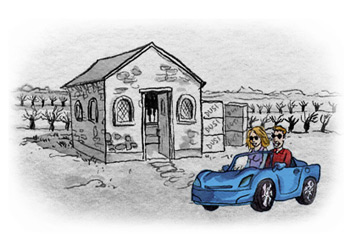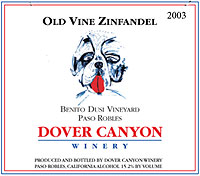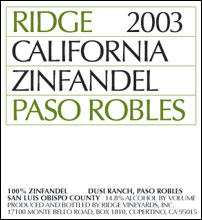

The old Dusi vineyard tasting room is a nostalgic vestige of a by-gone era in Paso Robles
Old Vine Zinfandel, $6 a Case: looking back at Dusi Vineyard
For the better part of a century, the Dusi family has been farming top quality Zinfandel in Paso Robles, and they’re still the source for some of the appellation’s most highly acclaimed vineyard-designated Zins.
by
Mary Baker
April 21, 2006
Many years ago, driving down Highway 101 to the beach towns of Morro Bay and Cambria, Dusi vineyard was a charming stop on the way to a clamming weekend with the wife and kids. Women wearing loose rayon sundresses, silk stockings and open-toed heels would accompany their husbands on the short walk into the Dusi tasting room – a small, separate cottage between the home and vineyard. Inside, a six-foot tasting bar hosted the southern side of the cottage. Magazines lauding the four San Luis Obispo County wineries that existed then are still carefully fanned out on the corner of that tasting bar today. I pick up the 1959 Sunset guide to California wineries. A two-page black-and-white spread with brief descriptions of the four wineries also includes photographs of sleepy Cambria, a rickety one-boat dock in Morro Bay, and a family clamming on a local beach.
In a daring leap of faith in their area’s tourism potential of the day, Central Coast Zinfandel grower Sylvester Dusi and his son Benito raised the price of their wine by ten cents a case. Dusi Zinfandel jumped from $5.90 a case to $6.00. They held their price at $6.00 a case for fifteen years – from 1959 to 1974.
In 1959 Benito Dusi was a young man in his mid-twenties. Although now in his seventies, it’s not hard to see Beni as the young man he was and always will be. He has a way of flashing oblique glances at me under his lashes, as though he knows a good joke but is too shy to tell it. He’s not tall, but he’s muscular in a wiry kind of way, standing upright with his shoulders unconsciously back and open, even when the room is cold. It is easy to see him as a young, bashful, and incredibly smart farmer.
I had driven to Beni’s vineyard on this balmy January afternoon to deliver our check for the previous vintage, but also to present him with copies of the accolades the 2003 vintage had received. “Really?” he asked. “Is this published in Manhattan Beach? I have a niece there,” he added. After pawing through the Wine Spectator, some Los Angeles newspapers, and the San Francisco Chronicle, Beni gave me a tour of the original family tasting room and winery. “Here,” he said, gesturing in front of meticulously dusted shelves containing several decades’ worth of antique wine bottles and defunct labels featuring Dusi fruit, “is where we stacked our wine cases. You could buy a case, or you could buy two one-gallon jugs for the same price.”
Next we visited the old winery barn. The large wooden barriques are gone, but Beni gestures to each corner, remembering the size and smell of each of his father’s 3,000 gallon wooden tanks. Workbenches hold trays of meticulously sorted nuts, bolts and washers, and spray-cans of paint and lubricant are lined up in rows like soldiers reporting for action. I stared in mild awe at a wall-sized stack of antique picking lugs, each wooden box assembled with exactly 40 iron nails.
“In 1965,” said Beni, “a friend and I delivered 1,016 boxes of grapes to Paul Masson in Soledad. That was when they first opened. The boxes weighed 7 pounds each, and each box had 50 pounds of grapes. We arrived late in the afternoon and the workers took one look at us and scattered!”
“Beni, what did you do?” I asked, distracted by the fact that he remembered the exact number of boxes, the weight, and the year.
“We worked. Hard,” he chuckled. “We lifted all those boxes of grapes off the truck and stacked them,” he said. “Then we moved them into the winery and restacked them.”
Benito Dusi’s tenacity and attention to detail is evident in the quality of his family’s heritage vineyard. The Benito Dusi Old Vine Zinfandel is always one of my favorite releases – it has a consistent profile of wild berry, briar, and mixed peppercorn that sets it apart from other Zinfandels.
Ridge purchases the lion’s share of this 80-year-old vineyard, as they have for about 25 years. As clearly as I can recall, Ridge was the first extra-appellate winery to actually put “Paso Robles” as an appellation on their label.
The Dusi vineyards are comprised of three family lots referred to as "Dusi Ranch.” The original 80-year-old vines planted by Benito's grandfather are still farmed by Beni himself. His brother Dante Dusi owns the property across Highway 101, which still contains two rows of 60-year-old vines, although he ripped out most of his vineyard in the 1960s and then replanted about 15 years ago. Benito's nephew Michael also owns an adjacent vineyard which is about 15 years old. For years most of the Benito Dusi fruit has been purchased by Ridge, with smaller lots traditionally going to local producers. Although all the Dusi family lots are extremely high quality, beginning with the 2005 harvest, only Ridge and Dover Canyon will purchase fruit directly from Benito Dusi.
Dusi is just one of many old vine Zinfandel and field-blend vineyards that exist in Paso Robles. Other venerated old vine vineyards still retain their original Italian monikers: Vosti, Bianchi, Pesenti, Martinelli. And of course, we still have a few grandfather vines from the old Paderewski ranch, established by Ignace Paderewski, one of the most popular concert pianists since Mozart, and a prime minister of Poland. But that’s another story for another day.
~ Mary Baker, Paso Robles Editor
To comment on Mary Baker’s writings and thoughts, contact her at m.baker@appellationamerica.com
In a daring leap of faith in their area’s tourism potential of the day, Central Coast Zinfandel grower Sylvester Dusi and his son Benito raised the price of their wine by ten cents a case. Dusi Zinfandel jumped from $5.90 a case to $6.00. They held their price at $6.00 a case for fifteen years – from 1959 to 1974.
In 1959 Benito Dusi was a young man in his mid-twenties. Although now in his seventies, it’s not hard to see Beni as the young man he was and always will be. He has a way of flashing oblique glances at me under his lashes, as though he knows a good joke but is too shy to tell it. He’s not tall, but he’s muscular in a wiry kind of way, standing upright with his shoulders unconsciously back and open, even when the room is cold. It is easy to see him as a young, bashful, and incredibly smart farmer.

I had driven to Beni’s vineyard on this balmy January afternoon to deliver our check for the previous vintage, but also to present him with copies of the accolades the 2003 vintage had received. “Really?” he asked. “Is this published in Manhattan Beach? I have a niece there,” he added. After pawing through the Wine Spectator, some Los Angeles newspapers, and the San Francisco Chronicle, Beni gave me a tour of the original family tasting room and winery. “Here,” he said, gesturing in front of meticulously dusted shelves containing several decades’ worth of antique wine bottles and defunct labels featuring Dusi fruit, “is where we stacked our wine cases. You could buy a case, or you could buy two one-gallon jugs for the same price.”
Next we visited the old winery barn. The large wooden barriques are gone, but Beni gestures to each corner, remembering the size and smell of each of his father’s 3,000 gallon wooden tanks. Workbenches hold trays of meticulously sorted nuts, bolts and washers, and spray-cans of paint and lubricant are lined up in rows like soldiers reporting for action. I stared in mild awe at a wall-sized stack of antique picking lugs, each wooden box assembled with exactly 40 iron nails.
“In 1965,” said Beni, “a friend and I delivered 1,016 boxes of grapes to Paul Masson in Soledad. That was when they first opened. The boxes weighed 7 pounds each, and each box had 50 pounds of grapes. We arrived late in the afternoon and the workers took one look at us and scattered!”
“Beni, what did you do?” I asked, distracted by the fact that he remembered the exact number of boxes, the weight, and the year.
“We worked. Hard,” he chuckled. “We lifted all those boxes of grapes off the truck and stacked them,” he said. “Then we moved them into the winery and restacked them.”
Benito Dusi’s tenacity and attention to detail is evident in the quality of his family’s heritage vineyard. The Benito Dusi Old Vine Zinfandel is always one of my favorite releases – it has a consistent profile of wild berry, briar, and mixed peppercorn that sets it apart from other Zinfandels.

Ridge purchases the lion’s share of this 80-year-old vineyard, as they have for about 25 years. As clearly as I can recall, Ridge was the first extra-appellate winery to actually put “Paso Robles” as an appellation on their label.
The Dusi vineyards are comprised of three family lots referred to as "Dusi Ranch.” The original 80-year-old vines planted by Benito's grandfather are still farmed by Beni himself. His brother Dante Dusi owns the property across Highway 101, which still contains two rows of 60-year-old vines, although he ripped out most of his vineyard in the 1960s and then replanted about 15 years ago. Benito's nephew Michael also owns an adjacent vineyard which is about 15 years old. For years most of the Benito Dusi fruit has been purchased by Ridge, with smaller lots traditionally going to local producers. Although all the Dusi family lots are extremely high quality, beginning with the 2005 harvest, only Ridge and Dover Canyon will purchase fruit directly from Benito Dusi.
Dusi is just one of many old vine Zinfandel and field-blend vineyards that exist in Paso Robles. Other venerated old vine vineyards still retain their original Italian monikers: Vosti, Bianchi, Pesenti, Martinelli. And of course, we still have a few grandfather vines from the old Paderewski ranch, established by Ignace Paderewski, one of the most popular concert pianists since Mozart, and a prime minister of Poland. But that’s another story for another day.
~ Mary Baker, Paso Robles Editor
To comment on Mary Baker’s writings and thoughts, contact her at m.baker@appellationamerica.com













